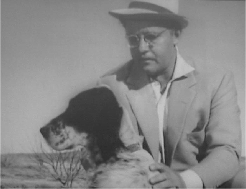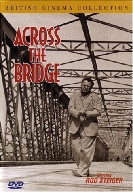|
my books don't make good
films
|| Early in 1938 the English
writer Graham Greene hung around Laredo waiting for a ride down to the Yucatan
and Chiapas where he was going to look into the plight of the Catholic
peasants. He must've written his story Across the Bridge based on those
days of hanging around the border... and Ken Annakin, the director of the film
version, must've taken further inspiration from Greene's train journey to the
border in order to invent the flight of the fugitive financier to a imagined
sanctuary in Mexico.
At the time [late fifties] Across
the Bridge established Rod Steiger as a serious lead actor following his great
supporting role as a mobster in On The Waterfront.
Prior to his death in 2002, Rod
Steiger considered this performance to be second only to his superb (and
similar) role in The Pawnbroker... while director Ken Annakin considers Across
the Bridge to be the best film he ever made. What about Greene, who wrote the
story on which Annakin and his writers based their script? He makes no mention
of this film in his book-length interview with the French critic
Marie-Francoise Allain [The Other Man: conversations with Graham Greene, 1981]
while touching on virtually every feature film made from his novels, including
Stamboul Train, The Third Man, Our Man In Havana, The Quiet American, The Power
& the Glory, et. al.
Maybe he didn't like it, viewed it
as an appropriation of a good story as a B-thriller with certain shabby
sub-plot additions. Then again, maybe he thought his contribution was minor
compared to the script writer Guy Elms' clever inventions. Annakin says his
film gained the best reviews of any J. Arthur Rank production "in years".
Annakin says he and Guy Elms thought they'd created a masterpiece... but in the
end they were forced to compromise.
All of this might seem beside the
point, except as a way of explaining the unevenness of this otherwise beautiful
little film. This asymmetry is theatrical, as the location is Spain [near
Seville] pretending to be the Texas-Mexico border country... with certain
English actors pretending to be Mexican. Thus the documentary sense of film
drama is compromised, although the latent surrealism is not dissimilar to Orson
Welles' dreamy border classic
A Touch of Evil,
also made in 1957.
the merging of two
shadows
Schaffner [Steiger], a German
financier with British citizenship, is in New York negotiating a merger with
the Manhattan Utilities Corp. when word comes that Scotland Yard has raided his
London office and seized some compromising files. The raid is shown as the
credits roll, an action montage of a black Wolsey police saloon racing through
the monochrome streets of 50's London. Three officers swiftly enter the
Schaffner Corporation office and present their credentials. The first image of
Schaffner is of a large photo mural on the wall behind his empty desk, just
like a cult icon of Stalin or Hitler.... Cut To: Schaffner's press conference
in New York. Here he looks like an executive but talks and acts like a Nazi.
When the telephone call comes about the raid, he immediately dismisses the
reporters and plots his escape. Quickly you learn that a) he has a mistress, b)
his wife committed suicide, c) he has a million dollars stashed in Mexico.
How long can he stay in Mexico
before extradition? Three months, his aide says. How long to get there? Six
hours by plane, two days by train. He decides to take the train as trains "have
no passenger lists". He dismisses his mistress, his aides, grabs a suitcase and
is gone.
For a ruthless man in a hurry the
train seems like an improbable choice... but as a setting, exists as a Graham
Greene favorite... and no doubt the director and producer had the American
market in mind, even though this was a U.K. production. Annakin actually did a
"second unit" journey with a cameraman from New York to the Texas-Mexico border
to acquire footage of the deco diesel and make photographic notes of the
locations. Most of the best action and cinematography occurs during the train
sequences, although the later action on and around the bridge is also very
cinematic. It's on the train that the central irony is developed, wherein fate
and chance conspire in a moralistic manner to subvert "coincidence", making it
an event in a deeper view of destiny.
Criminals often steal the
identities of others in order to escape... but what if the criminal assumes the
identity of someone who turns out to be a hotter criminal than he is? It's like
having drinks with Lee Harvey Oswald, then mugging him for his passport and
expecting to leave Dallas incognito. Yet this is exactly how it should be, for
when Schaffner (Steiger) drugs and mugs Scarff (Nagy) and dumps him from the
train following their chance encounter, the event is symmetrical, like the
merging of two shadows into a doppelganger. The whole transfer of identity is
conducted like a sinister sexual act in Schaffner's compartment, and certainly
demonstrates some great acting by Rod Steiger and Paul Nagy, with the various
sequences edited flawlessly.
The first indication that things
aren't going as smoothly as anticipated by Schaffner in his new incarnation as
"Scarff" comes the moment he exits the train in Flowerville, a small Texas town
some 15 miles from the border. Seems that Scarff was travelling with a dog,
which was in the baggage car... and the guard is quick to make sure that his
owner doesn't forget her. Thus the insensitive fugitive becomes saddled with an
animal and despite repeated attempts to get rid of it, is forced into a
defining relationship which becomes the most important part of the action in
the second half of the film. This is the part that is most closely based on
Greene's short story.
the re-invention: de Sica
& Carne
As Schaffner wanders the border
towns of Texas and Mexico like a refugee with "Dolores" in tow, some will be
reminded of the old Italian pensioner
Umberto D. in
Vittoria de Sica's brilliant 1952 film who wanders the streets of post-war Rome
with his dog Flick, both homeless and unwanted. To anyone familiar with de
Sica's film, the influence is undeniable, although the re-invention is just as
charming and tragic in its own way.
Of course, de Sica borrowed his dog
motif from Marcel Carne's Port of Shadows (1938), and as Greene was also a film
critic, his story also might've been influenced by Carne's moody tragedy. So
too the Annakin-Elms script. Port of Shadows tells the story of a deserter from
the French colonial army who assumes another man's identity in his bid to
escape to Venezula. He saves a stray from being run over by a truck and ends up
being followed by the dog around the foggy industrial wasteland of the Le Havre
dock zone.

If there's any pandering in this
film it comes with the inclusion of Johnny the tow-truck driver and his girl
Mary from the garage/cafe/motel called Sam's. While they perform key actions
that occur at key plot-points, their inclusion was clearly the compromise Ken
Annakin refers to in his interview [The Making of Across the Bridge]. No doubt
the producers wanted more love in this very loveless film, and to widen the
audience demographic. Did Graham Greene approve? Probably not. But he did say
"my books don't make good films".... although he was speaking generically about
his difficulty in conveying action. His story, originally published in a 1938
U.K. edition of Argosy, appears to have been based on a border stopover he made
en route to an assignment in Mexico.
the verb to escape keeps
recurring
There are a number of amusing
twists in the story at this point. While Schaffner manages to get himself
across the bridge and into Mexico, his situation just gets worse. His financial
crime becomes irrelevant when replaced by his crime of turning-in the real Paul
Scarff for the reward... for although Scarff assassinated a Mexican governor he
was a hero to the locals... and the Police Chief is (typically) corrupt. What's
worse is that Haddon, the English police Inspector who now shows up, is willing
to commit a crime himself in order to get his hands on Schaffner. Throughout
this ordeal the only friend he has is Dolores, the floppy-eared mongrel who
saves him from a scorpion in the desert. During the scorpion sequence, the de
Sica influence is noticeable in the background music which sounds just like his
composer of choice, Nino Rota.
Greene's story has an anonymous
narrator [who might be the writer] and is confined to the two border towns. The
fugitive is an Englishman called Joseph Calloway and there is no assassin
called Paul Scarff. Calloway has a dog which he treats badly... and love, when
it comes, is pure illusion without redemption. "I suppose it was only one more
indication of a human being's capacity of self-deception, our baseless optimism
that is so much more appalling than our despair."
For Graham Greene, his journeys
were often escapes. As Francoise Allain notes, "the verb to escape keeps
recurring in (Greene's) conversation." He was always uneasy in the U.S.A.
...and in this sense the script writer Guy Elms and the director Ken Annakin
captured an essential aspect of Greene's bleak vision, especially in the
treacherous ending where escape becomes secondary to the need for love.
Thus the whole film is a dossier
of "Greeneland" corruption: Schaffner the swindler, Scarff the assassin, Johnny
the greedy mechanic, the shifty Mexican police chief, Haddon the zealous
English cop... in fact the only characters with virtue are the two female
principals, Johnny's fiance Mary and Scarff's Mexican widow. Both women have
few lines and little action, are decorative rather than dramatic... yet they
exist with the serious, silent power of the Catholic Madonna... agents of guilt
in the brutal world of men. The true simplicity of this is symbolized by
Dolores the dog, of course.
Still, without the intensity of
Rod Steiger's performance the film might've been just another 50's chase
thriller despite the Greene pedigree. Steiger's role here certainly prepared
him well for the deeper psychological reprise 10 years later as the German Jew
Sol Nazerman in Lumet's pivotal film The Pawnbroker. And also his sinister,
edgy performance in The Illustrated Man. All these characters are outsiders,
fugitives from past trauma and the conditional present.
Needless to say, some critics call
Across the Bridge film noir because it's in black and white and involves
crime. But it has none of the main characteristics of noir -- that is, a
manipulative femme fatale, a male patsy, and expressionist cinematics. It
belongs rather to the group of great British naturalist films made in the 50s
and 60s [Room At The Top, Seance on a Wet Afternoon,
This Sporting
Life] that follow the tradition of Italian neo-realism that features
ambient sound and real-time sequencing... but with more modern editing to
accommodate its action modality.
Remade 2001 as Double Take, dir.
George Gallo, star. Orlando Jones.
© LR 7/04
Fcourt |
